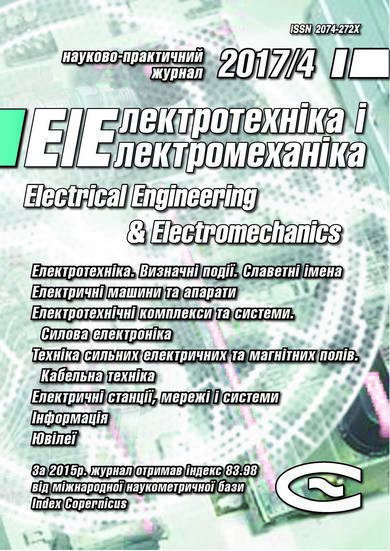IMPROVED ALGORITHM FOR CALCULATING COMPLEX NON-EQUIPOTENTIAL GROUNDING DEVICES OF ELECTRICAL INSTALLATIONS TAKING INTO ACCOUNT CONDUCTIVITY OF NATURAL GROUNDINGS
DOI:
https://doi.org/10.20998/2074-272X.2017.4.11Keywords:
natural concentrated groundings, substitution, induced potential method, the potential distribution, a two-layer ground modelAbstract
Purpose. The method of natural concentrated groundings substitution by the set of electrodes taking them into account in the algorithm of electric characteristics calculation for complicated grounding connections of electric installation is offered. An equivalent model as a set of linear electrodes is chosen in accordance with two criteria: leakage resistance and potentials on the ground surface. Methodology. We have applied induced potential method and methods for computing branched electrical circuits with distributed parameters. Results. We have obtained the algorithm for calculating complex non-equipotential grounding connections, which makes it possible to obtain refined values of the potential distribution in the electric stations and substations with outdoor switchgear. Originality. For the first time, we have taking into account the conductivity of natural concentrated grounds by a set of vertical and horizontal electrodes based on equivalent electrical characteristics applied to a two-layer ground. Practical value. The using of the proposed calculation algorithm in the electric grids of JSC «Kharkivoblenergo» made it possible to determine the values of the potential distribution at short circuit in electrical substation taking into account the influence of the conductivity of natural concentrated groundings.
References
1. Link I.Yu., Koliushko D.G., Koliushko G.M. A mathematical model is not an equipotential ground grids substation placed in a double layer. Electronic modeling, 2003, vol.25, no.2, pp. 99-111. (Rus).
2. Matveev M.V., Kuznetsov M.B., Lushchishin A.R. Evaluation of the electromagnetic environment in the power station and substations engineering. Vesti v elektroenergetike, 2005, no.2, pp. 1-8. (Rus).
3. Katsanou V.N., Papagiannis G.K. Substation grounding system resistance calculations using a FEM approach. IEEE Bucharest PowerTech, Jun. 2009. doi: 10.1109/PTC.2009.5282044.
4. Burgsdorf V.V., Yakobs A.I. Zazemlyayushchie ustroystva elektroustanovok [Grounding device of electrical installations]. Moscow, Energoatomizdat Publ., 1987. 400 p. (Rus).
5. Pravila ulashtuvannya elektroustanovok. Rozdil 1. Zagal'nі pravila. Glava 1.7. Zazemlennya і zakhisnі zakhodi vіd urazhennya elektrichnim strumom [Rules of the device electroinstallations. Chapter 1. General rules. Grounding and protective measures against electric shock]. Kyiv, Mіnenergovugіllya Ukrayiny Publ., 2011. 72 p. (Ukr).
6. Fedoseenko E.N. Minchenko A.A. The substitution option of natural concentrated grounds, such as concrete pole armature, by the calculated set of electrodes. Eastern-European Journal of Enterprise Technologies, 2006, vol.3, no.6(24), pp. 81-84. (Rus).
7. Minchenko A.A., Fedoseenko E.N. Taking into account the natural conductivity of current spreading with concrete pole armature for calculation complicated grounding connections by the set of vertical electrodes. Bulletin of NTU «KhPІ», 2006, no.28, pp. 96-100. (Rus).
8. Fedoseenko E.N. Finding of mutual and own resistances of vertical and horizontal electrodes for complicated grounding connections in a double layer ground. Bulletin of NTU «KhPІ», 2006, no.34, pp. 84-91. (Rus).
9. Demirchian K.S., Neiman L.R., Korovkin N.V., Chechurin V.L. Teoreticheskie osnovy elektrotekhniki: V 3-kh t. Uchebnik dlia vuzov. Tom 2 [Theoretical bases of electrical engineering. In 3 vols. Vol.2.]. St. Petersburg, Piter Publ, 2003. 576 p. (Rus).
Downloads
Published
How to Cite
Issue
Section
License
Copyright (c) 2017 K. A. Starkov, E. N. Fedoseenko

This work is licensed under a Creative Commons Attribution-NonCommercial 4.0 International License.
Authors who publish with this journal agree to the following terms:
1. Authors retain copyright and grant the journal right of first publication with the work simultaneously licensed under a Creative Commons Attribution License that allows others to share the work with an acknowledgement of the work's authorship and initial publication in this journal.
2. Authors are able to enter into separate, additional contractual arrangements for the non-exclusive distribution of the journal's published version of the work (e.g., post it to an institutional repository or publish it in a book), with an acknowledgement of its initial publication in this journal.
3. Authors are permitted and encouraged to post their work online (e.g., in institutional repositories or on their website) prior to and during the submission process, as it can lead to productive exchanges, as well as earlier and greater citation of published work.





